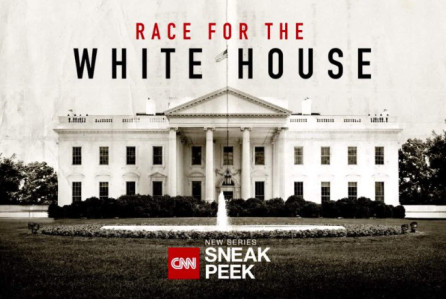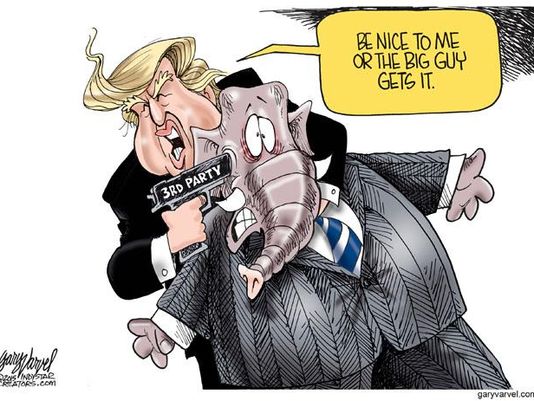
Currently on the cable news channel CNN (and why it’s on there I have no clue, except for the factor that news channels are “entertainment” channels nowadays) is a six-part documentary series (ah, THAT’S how they play it off as “news”) delving into the history of the campaigns for the Presidency of the United States. Race for The White House, narrated and produced by House of Cards actor Kevin Spacey, looks back at six campaigns from the jaded history of the country and the lengths (some would say depths) that people would go to ensure that their candidate was ensconced in the White House. Last week’s episode dealt with the 1960 Presidential election between John F. Kennedy and Richard M. Nixon (I already knew the story and thusly bypassed it) and this week’s episode – unless its preempted for “Breaking News” (“Hey, someone found a piece of that Malaysian plane that’s been missing for two years!”) – will look at the 1860 fight between Abraham Lincoln and Stephen Douglas.
To say that the 2016 Presidential campaign has been unique and may someday be a part of the 75th anniversary of Race for the White House on the Interstellar News Network (INN) would be an understatement. For the most part, however, it isn’t two parties or candidates going after each other that have made this a campaign that has either been memorable or an embarrassment, depending on viewpoint. It is one person whose repeated usage of inflammatory rhetoric has, indeed, drawn an audience of knuckle-draggers out of the woodwork that have repeatedly attacked even the slightest hint of protest at his campaign rallies. Now, however, the chickens are coming home to roost.

Of course, we are talking about Donald Drumpf, who has led the charge for the Republican Party after eight years of heated, borderline racist rhetoric of their own that castigated the twice elected President Barack Obama. It started for Drumpf with the 2012 election when he drove the “birther” movement (even after it had calmed down in most Republican circles) and Trump himself fanned the flames higher. “You won’t believe the information my investigators have found,” the Orangutan Mutant crowed in news conferences – that was before Obama stood up, showed a full birth certificate showing his place of birth to be Hawaii and basically told Drumpf to put up or shut up (note: Drumpf shut up).
When Drumpf announced his run for President in 2016, he simply continued the divisive, racist, xenophobic and misogynist rhetoric that he has parroted since he entertained thoughts of running for the office in the late 1990s. No matter the nationality or region – Mexican, Syrian, South American, Asian – nor the ethnicity or religion, Drumpf has cursed them all, pumping his StormTrumpers with an Aryan vision of “making America great again.” Then, when things got violent, Drumpf simply ratcheted the verbosity and tension even more.
Since that day in June 2015, Drumpf has continually encouraged his rallygoers to verbally and physically attack those in the crowd that would even think to disagree with him. In February, Drumpf literally said if someone at one of his rallies saw someone even giving the slightest appearance of trying to disrupt his speech to “knock the crap out of them, would you? Seriously. OK, just knock the hell – I promise you, I will pay for the legal fees. I promise, I promise.”
So what do you think happened?
On March 8, a member of the Drumpf crowd DRESSED IN HIS KOREAN WAR VETERANS ASSOCIATION GARB pushed and threatened a black protestor in Louisville, KY, forcing the WOMAN from the rally for apparently protesting too much (there is no video of what she did). The man, Al Bamberger, has since repeatedly apologized to his Veterans’ Chapter and his family, but basically has handed out a big “fuck you” to the woman whom he assaulted. So has Drumpf, who encouraged the actions from the stage (as he has virtually every one of the altercations at his rallies).
Another Drumpf rally on March 10 got even worse. As Cumberland County Sherriff’s Department officers escorted two men from the Crown Coliseum in Fayetteville, racial epitaphs reportedly were hurled by the crowd towards both black men. Then another man, John McGraw, stepped up and sucker-punched one of the men as he walked by. Instead of apprehending McGraw for the assault, Cumberland County officers tackled the punched man and quickly got him and his partner out of the Coliseum. It wasn’t until the next day – and after the tabloid show Inside Edition interviewed McGraw with him saying “Yes, he deserved it. The next time we see him, we might have to kill him…he might be with a terrorist organization” – that the Cumberland authorities got around to arresting McGraw for assault (an investigation is ongoing by the Sheriff’s Department as to why they didn’t act at that time).
Then there’s Drumpf’s treatment of the press. Breitbart.com reporter Michelle Fields – and Breitbart is a conservative-leaning website that has been VERY closely associated with promoting the Drumpf campaign – was allegedly accosted by Drumpf campaign manager Corey Lewandowski while the campaign was in Florida on Friday. Fields filed charges of assault against Lewandowski and displayed bruising on her arm where she said she was “forcefully grabbed” by Lewandowski, who doesn’t say he didn’t do it but calls Fields “delusional” and the campaign says is “entirely false.” There is video, however, of Lewandowski being within close proximity to Fields while Drumpf is departing a press engagement and, at a point, her body jerking back violently, giving credence to her side of the story. The investigation is ongoing.
And this all has gone on while the Orangutan Mutant continues to up the ante, increase the bile in every speech and ratchet up the rhetoric to histrionic proportions. But what happens when the odds are evened up and it isn’t a screaming horde of a few hundred people against one or two? Drumpf and his supporters scream like little weaklings with their panties in a bunch and say that their rights are being violated!
On Friday, Drumpf scheduled two rallies, one in St. Louis and the other in Chicago, and everything short of street warfare broke out. Outside of the St. Louis rally, protestors from both sides clashed and, in what has become a usual occurrence inside a Drumpf rally, the speeches were interrupted on more than a dozen occasions. That just served as the appetizer for Chicago, where the crowd was evenly split and, this time, Drumpf’s campaign decided not to hold the rally out of “security concerns.”
Now these protesters were apparently organized by the Black Lives Matters and MoveOn.org groups, but that isn’t a point worth arguing. When it came time for Drumpf to actually have to face off against those whom his supporters have targeted for attacks time and time again, they decided to back off. Drumpf himself then whined about his “First Amendment” rights and how he had a right to hold his rallies.

Let’s get something straight here. Yes, everyone has a First Amendment right to say whatever the hell they want to say (and that the First Amendment is there to prevent the GOVERNMENT from infringing on that right). In utilizing that First Amendment right, you also have to accept the ramifications of what comes from that exercise. If your rhetoric is constantly demeaning of – well, virtually everyone – then you have to expect that you are going to get some backlash at some point from the targets of your vitriol.
Those protesters have the same right to be heard. Now there may be a question as to the usage of violence (and that is one that can be asked on both sides), but there should be no question that protesters can call out the Orangutan Mutant and his slobbering horde for their idiocy. That First Amendment thing? It works both ways.
What doesn’t work is to try and act like you haven’t done anything to aggravate the situation. For most of Friday evening and into Saturday (a Cincinnati Drumpf rally was also canceled due to “security concerns” while another in Dayton saw the Secret Service perform their duties admirably when a potential threat rushed the stage, surrounding Drumpf in a protective cocoon), Drumpf tried to say that he hasn’t said anything onstage to encourage his supporters to take the actions that have occurred, that there is nothing he regrets having said, that he is completely innocent regarding the “issues.”
To that, everyone – whether you agree with the Orangutan Mutant or don’t – has to raise up and loudly say “BULLSHIT!” Drumpf is the one that has turned the 2016 Presidential campaign into the shitshow that it has become, that has tossed it into the racial commode and continues to stir the malodorous pot. There’s an ever-so-slim chance that someone might get to Drumpf and see if he can walk it back a bit…if not, then I fear it’s going to get worse, perhaps to the point of dead bodies worse, rather than improve.



